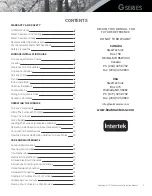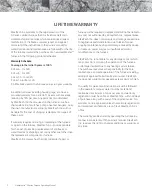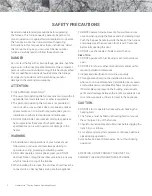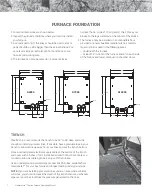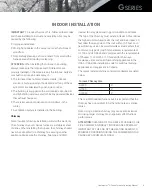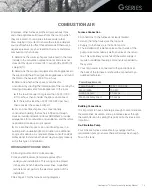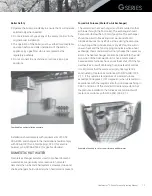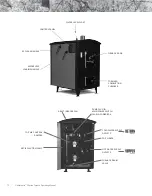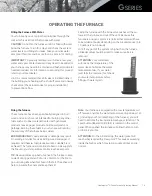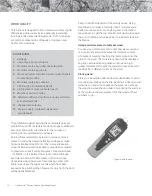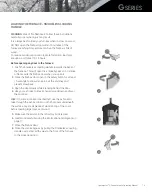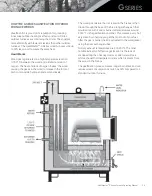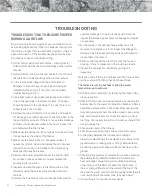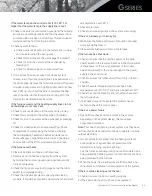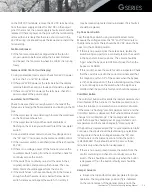
11
Heatmaster
ss
G Series Furnace Operating Manual
The pump and loop should be plugged in and valves open
at the marked outlet in the rear electrical box whenever
the furnace is in use. Under no circumstances should this
pump or piping be used to service distribution piping to
buildings. The outlets provided for distribution should be
connected to separate pumps and piping properly sized for
their respective heat load requirements.
The circulation pump has three speeds and should be set
according to the model of the furnace.
G4000 - Speed #2
G7000 - Speed #2
G10000 - Speed #3
The recirculation pump must be unplugged whenever the
furnace is not filled with water.
Underground Hydronic Lines
Rhinoflex pipe by Heatmaster
SS
is your best value for long
lasting underground pipe with the most efficient insulation
used in insulated pipe resulting in minimal heat loss
between your furnace and building. Contact your local
dealer to purchase.
Hydronic lines (hot water heating lines), whenever buried
or encased in cement should not be spliced. Take the
necessary steps to ensure they stay dry. This ensures that
minimal heat loss occurs. Supply and return lines should be
at minimum of 1” and have a rating of 100 PSI capacity of
180° F.
Hint:
To easily identify supply and return lines, Rhinoflex
Insulated pipe includes one pipe with a black stripe and one
pipe blank.
Interior Connections
You may require either a water-to-water (tube and shell
or plate) or a water-to-air exchanger (rad) to transfer heat
energy from the hot water your furnace has produced. Your
plumber or dealer can design and install a system to best
fit your needs. The following are examples of basic interior
connections. Your dealer carries the necessary parts for
installation.
It is important to note that when installing your piping
system in your building that you should avoid installation
methods that cause too great a restriction in the piping
system. Examples of this are reducing pipe size, an
excessive amount of joints and elbows, etc.
It is also important to install air bleed valves at high points
in the system to avoid an air lock, especially if these
points are higher than the furnace. Airlocks can restrict
system flow limiting the BTU’s available to your building.
This may also lead to your furnace overheating and cause
temperature swings in the water feeding the house.
DISCLAIMER:
The following information in the interior
connections are examples and suggestions only. When
installing a furnace and its parts it is best to consult your
local dealer or a qualified technician.
Water-To-Water Heat Exchangers
To maintain pressure in an existing boiler system while
using an outdoor furnace, a water-to-water heat exchanger
is used. The water-to-water exchanger is installed inline on
the return side of the existing pressurized boiler system.
Flat Plate Exchanger for Pressurized Boiler Systems
Flat plate exchangers are used with pressurized systems
such as boilers. The flat plate transfers heat in to the water
in the boiler return line pressurized system while keeping
the two systems separate. Because an outdoor furnace
is an open system (not pressurized) and the system tied
in to this type of application is pressurized, it allows both
systems to stay the same while being operational. The
water supplied by the outdoor furnace will heat the water
in the pressurized system while the present heat source in
the pressurized system (such as a boiler) can be used as
a backup heat source in case of an emergency or need for
additional heat. When connecting the furnace to an existing
pressurized boiler system:
•
The furnace must not be installed so that it interferes with
normal heat delivery of the existing boiler system.
•
The furnace must be installed without affecting the
operation of the electrical and mechanical safety controls
of the original boiler.
•
The furnace must provide for a changeover from one fuel
to the other without requiring manual adjustment of any
controls or components other than the thermostats.
•
The furnace must have provisions for preventing, or
adequate water capacity within the boiler to prevent
damage from loss of circulation due to electrical power
failure.
•
The furnace must be installed without changing the
function of the controls or rewiring the original boiler. A
wiring interconnection is permitted. The electrical system
of both boilers shall be powered from a single branch
circuit without exceptions.



